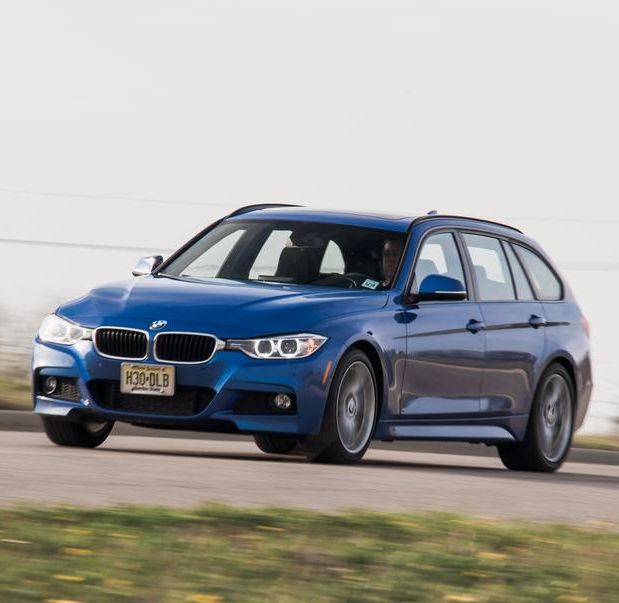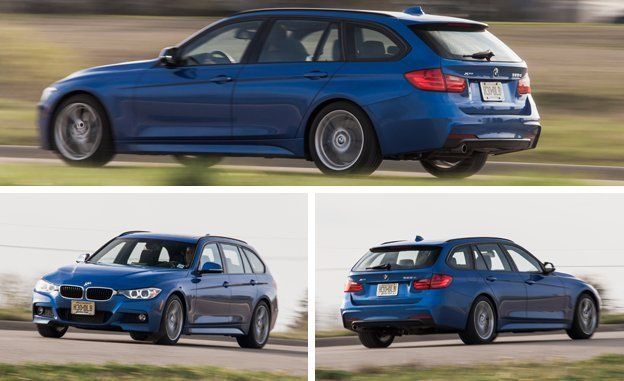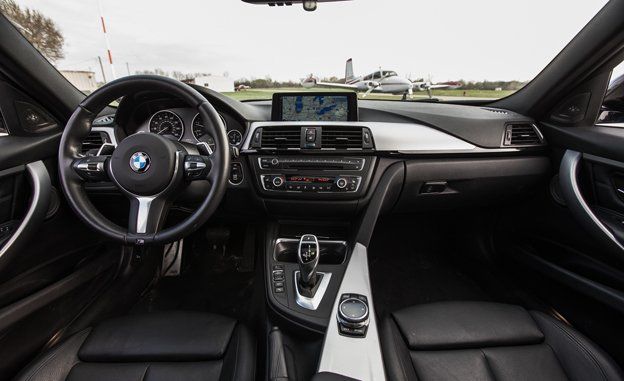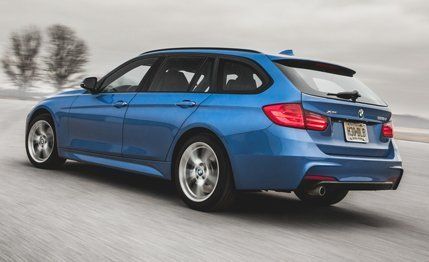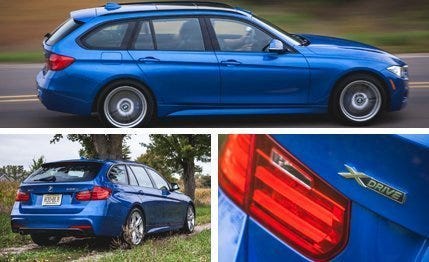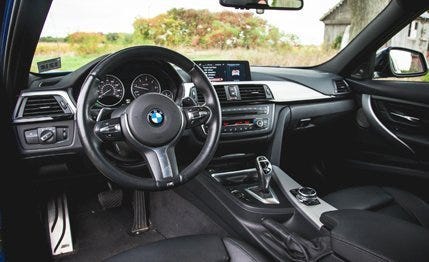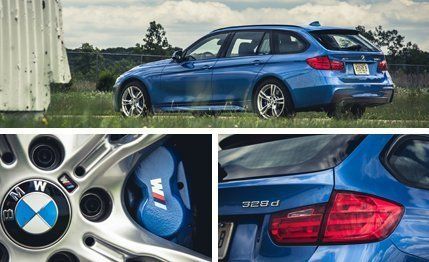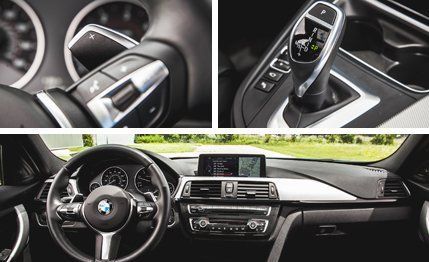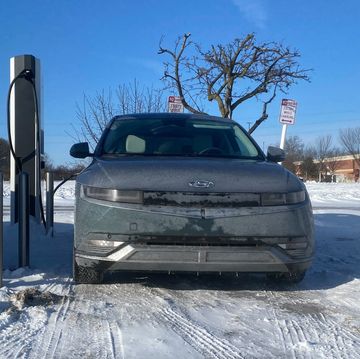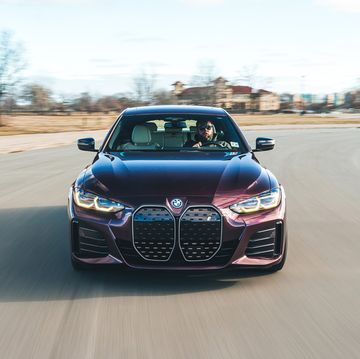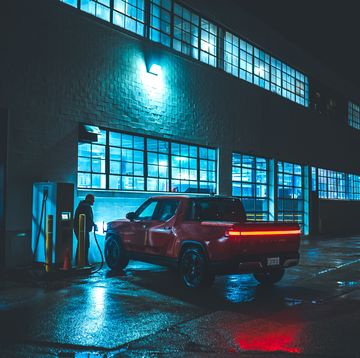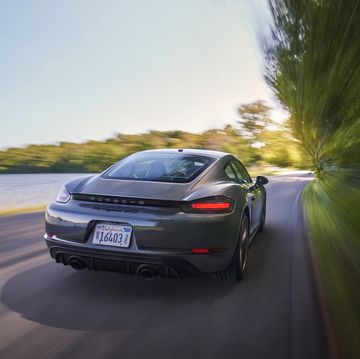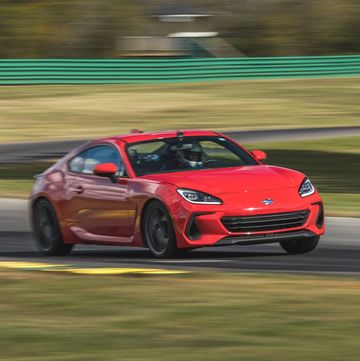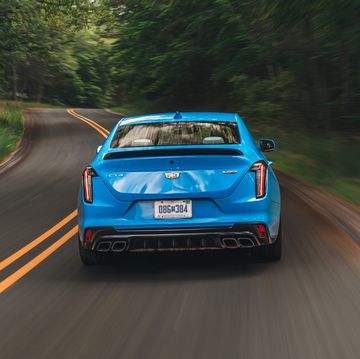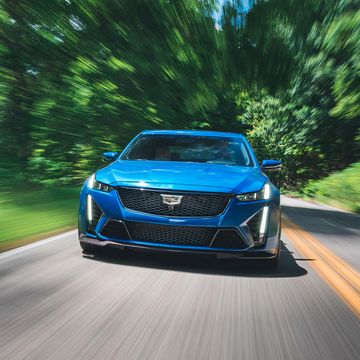Say the words “diesel station wagon” around a group of European enthusiasts and they’ll yawn. Do the same thing in America, though, where such cars are exceedingly rare, and rivulets of sweat form on foreheads. Pulses quicken. Eyes widen. We should know—this happens to us. It’s because diesel wagons play into an automotive fantasy: the do-it-all vehicle that delivers great fuel economy, sedanlike dynamics, and enough utility to perhaps permanently stave off the purchase of a soul-crushing minivan or crossover. So it was pretty obvious which body style we’d spec when we were offered a chance to put 40,000 miles on a 3-series with BMW’s latest four-cylinder diesel engine.
With the red mist of capacious, compression-ignition cars filling our eyes, we gleefully ignored the fact that essentially everything appealing about the 328d xDrive Sports Wagon is available for its relatively sensible $44,000 base price: all-wheel drive (rear-drive isn’t offered in the U.S.-spec wagon), diesel efficiency, enlarged cargo capacity, and plenty of luxury features. We needed more, dammit.
So in went the $3850 M Sport package (18-inch wheels and performance tires, sport seats, M steering wheel, black-out exterior trim, aluminum interior trim, black headliner, and a body kit), which allowed us to select the $550 Estoril Blue paint. We then added $650 M Sport brakes, $250 rear sunshades, $875 Harman/Kardon surround sound, and a $750 camera setup to see 360 degrees around the car, because apparently we lack necks with which to turn our heads. But, oh, that’s not all! There were also six additional packages—for the full rundown, head to our intro story—that totaled more than $9000. We didn’t stop ticking boxes until the thing cost almost 60 grand, an eye-watering level that almost never failed, justifiably, to garner a mention in the logbook. (One logbook commenter went so far as to call this particular car “the single-most salesproof BMW in America,” although we had an unprecedented number of readers and staffers inquire about purchasing the vehicle from BMW after the test.)
Yet for all the squealing about the price, the diesel four-cylinder engine came in for the most complaints, on account of its lack of refinement, loudness at low speeds, and uneven power delivery. Its coarse nature came to the fore at every stoplight, as the fuel-saving automatic stop-start feature relit the engine with a pronounced shudder and audible gruffness. The engine was derided as unbefitting any vehicle in this segment, much less one with an MSRP as high as ours. Some tried to make excuses: “You don’t notice it when you’re cruising, only when you’re accelerating!” Which is, well, a lot of the time. Volkswagen, Audi, and Mercedes all offer better-behaved diesel fours, although only VW puts theirs into a proper wagon. Ordering BMW’s gasoline-powered turbo four in the wagon would eliminate the most egregious of the issues, and it would also provide the benefit of a more widely available and price-stable fuel.
The diesel engine was potent enough for everyday commuting, however, with its 280 lb-ft of torque giving a sprightly feel off the line and the launch-control program—yes, this wagon has launch control—enabling a 7.0-second final zero-to-60 run, 0.1-second quicker than when it was delivered. The engine improved a bit more at higher velocities, gaining 0.7 second to 100 mph by the end of the test. But few could forgive the diesel’s “can of gravel” racket, even as they appreciated its thrift and long range on highway cruises.
Indeed, the BMW went far and wide on our side of the Mississippi, making frequent jaunts to northern Michigan, Chicago, Pennsylvania, and New England, as well as one-off trips to Virginia as a Lightning Lap support vehicle, to Nashville, and to northern Wisconsin. The highway miles helped enable a very respectable 35-mpg average for the 40,000-mile test, which is even more impressive considering most of those trips involved multiple passengers and a cargo hold full of gear. (Our mileage might have been a smidge higher, too, if we hadn’t disabled the stop-start function for much of the test.)
Other qualities contributed to the filled-up sign-out sheet: a highway range that easily topped 500 miles between refueling stops, good forward visibility, crisp handling, a well-sorted chassis—outside of the numb steering—and a comfortable ride, even with our M Sport car’s more aggressive suspension, larger wheels, and run-flat performance rubber. The car also was an all-weather tank, with the xDrive all-wheel-drive system combining with a set of Pirelli Sottozero winter tires to make the BMW virtually unstoppable when the snow was flying.
Unfortunately, the xDrive setup also had problems, as the transfer case went bad and needed to be replaced at 25,000 miles (more details on the fix here). We had other reliability issues, too. For the first half of its stay, the 328d repeatedly warned us of excessively worn brake pads and required multiple service visits to track down the cause; a worn pad-level sensor threw the false alarms, and we did not need to replace the brake pads during our time with the car. Early on, one of the headlamp-leveling sensors failed and caused the lights to dip extremely low and go into “truffle-hunting mode,” as it was termed. The interior, which wore well otherwise despite heavy use, also developed some small rattles. We were to blame for a broken right-rear sunshade; someone ripped off the pull tab, causing the shade to drop into the door.
All of the problems were fixed under warranty, and since service (oil changes, inspections, diesel exhaust-treatment fluid refills, etc.) is included with all BMWs for four years or 50,000 miles, our out-of-pocket outlay for the test was zilch. Still, as we wrote in a previous update, the gremlins were frequent enough to remind us why one should avoid BMWs that are out of warranty.
Would we be more forgiving if the car had been perfectly reliable, or if we had been more judicious with the options? Perhaps. But the fact is that the source of the most grumbling—the unrefined and clattery diesel engine—comes standard, and the car’s efficiency, everyday livability, and dynamic goodness weren’t enough to call our diesel-wagon fantasy completely fulfilled.
Months in Fleet: 14 months
Final Mileage: 41,208 miles Average Fuel Economy: 35 mpg
Fuel Tank Size: 15.0 gal Fuel Range: 525 miles
Service: $0 Normal Wear: $0 Repair: $0
Damage and Destruction: $0 Unscheduled Urea-Solution Additions: $0
WHAT WE LIKE: The reasons we love a cold beer on a sweltering summer day don’t change, but that doesn’t make the experience any less refreshing in the moment. So it goes with each stint behind the wheel of our long-term BMW 3-series wagon. Supporters love its fuel economy (35 mpg overall), impressive range (500-plus miles), and oddball style. Multiple drivers have also praised its relaxed highway demeanor, roomy cargo area, and linear torque delivery, with one of our editors saying he’d seriously consider a 328d wagon for his own garage if he were currently in the market for a new car.
WHAT WE DON’T LIKE: The impeccable freeway behavior contrasts greatly with what many see as the car’s lack of refinement around town. The four-cylinder diesel growls and rasps under acceleration (like shaking “a can of gravel,” in the words of one commenter) and is basically a deal-breaker for many on staff for whom a smooth, refined inline-six engine remains the mechanical definition of a BMW. Lower speeds and cold startups have revealed the development of a couple of interior rattles, including one from the dashtop center speaker. We’re also not fans of the audible clunk when you move your foot to the brake pedal; it makes it seem as if the pedal is a little loose (it’s not) and imparts a whiff of cheapness. The relative cost of diesel to gasoline as of this writing—it’s roughly a buck more per gallon—isn’t doing this car any favors, either.
WHAT WENT WRONG: The fix reported in our last update took and the car has finally stopped throwing codes for worn rear brake pads, so that’s good. Not so good was the minor powertrain shudder we were experiencing at low speeds; thinking it might be an engine misfire or perhaps a transmission issue, we took the BMW to the dealer at 25,000 miles. There, the techs traced the problem to a defective transfer case. (The shudder disappeared when they disconnected the control module, thereby briefly turning our wagon into a rear-driver.) The transfer case was replaced under warranty—thankfully, too, as the case can retail for nearly $4000 on its own before labor and seals and such. Chalk up another hash in the column labeled “Reasons Never to Buy a BMW Out of Warranty.”
We also went in for a service at 31,700 miles, which entailed a refill of the exhaust-treatment fluid, an oil change, and various inspections. This cost us nothing as part of BMW’s four-year/50,000-mile free routine maintenance. Finally, the undercarriage was sprayed by a supremely lucky skunk, who, like a jerk, jumped out from the bushes as we drove by, passed between the front wheels, hosed down the car with his butt musk, and escaped death by scampering out from under the driver’s side before the rear wheel ground him into a paste. A thorough cleaning combined with a couple hundred miles of airing out took care of the stench.
WHERE WE WENT: Since our last update, our 328d has made a few medium-range trips to environs such as Rochester, New York; Nashville; Chicago; and Charlevoix, Michigan. While overall mileage remains unchanged at 35 mpg, we had two tanks of fuel eclipse the 43-mpg mark.
Months in Fleet: 11 months
Current Mileage: 33,403 miles Average Fuel Economy: 35 mpg
Fuel Tank Size: 15.0 gal Fuel Range: 525 miles
Service: $0 Normal Wear: $0 Repair: $0
Damage and Destruction: $0 Unscheduled Urea-Solution Additions: $0
WHAT WE LIKE: We’re still enjoying the long-haul capabilities of our blue BMW and have taken advantage of its range to go on more long road trips. Overall fuel economy continues to tick upward by tenths of a mile per gallon, although our overall average is still 35 mpg. The styling and practicality of the wagon body remain high points for staffers and their families, and its quirky nature appeals to something deep in our lizard brains. Plus, kids love to stare out of the huge panoramic sunroof to see the tops of Michigan’s huge oak trees, gliding hawks, government drones, etc.
WHAT WE DON’T LIKE: As with our Backfires members, staffers can’t stop commenting on this car’s inflated price tag. Yes, we went a little nuts with the options. Yes, a cheaper one would suffice. But one logbooker makes some sense when he writes, “The $60K price is basically irrelevant. Few people are going to cross-shop this car in the first place”—it is, as we wrote in its introduction, a veritable automotive unicorn—“as most will have zeroed in on it long before hitting the dealership.” The harshness and volume of the engine noise remain sore spots, especially for those outside of the car on startup.
WHAT WENT WRONG: Unfortunately, a software reflash didn’t fix the false alarms for brake-pad wear—the car told us they needed to be replaced again at 16,800 miles. They didn’t; corrupted data was found, and another reflash was performed. This didn’t fix it, and the warning chime tolled again at 17,700 miles. The dealer finally found “wear” to the rear brake-pad sensor and replaced it under warranty. We also had a scheduled service performed at 22,000 miles, which involved an oil and filter change, an inspection, an air-filter swap, and a top-off of the AdBlue exhaust-treatment fluid. This cost us nothing, as did the warranty fix performed at the same time for a broken rear-passenger sunshade; it had fallen into the door after the tab for lifting it was snapped off by someone among our ranks.
WHERE WE WENT: Since last checking in with our Estoril Blue hauler, it has made several jaunts the length and breadth of Michigan, as well as ventured to the far side of Pennsylvania and back twice, averaging more than 42 mpg on one leg.
Months in Fleet: 8 months
Current Mileage: 24,761 miles Average Fuel Economy: 35 mpg
Fuel Tank Size: 15.0 gal Fuel Range: 525 miles
Service: $0 Normal Wear: $0 Repair: $0
Damage and Destruction: $0 Unscheduled Urea-Solution Additions: $0
WHAT WE LIKE AND WHY: Our diesel 3-series wagon has proved desirable for long trips, with logbookers praising the car’s comfortable ride and large range. We could feasibly venture from our Michigan office to locations as far flung as New York City, Des Moines, Chattanooga, or maybe even Hearst, Ontario, Canada, without stopping once for fuel. If you’re into the round-trip thing, note that one of our editors drove to Chicago, tooled around for the weekend, and returned to his Ann Arbor home with plenty of range to spare. We’re also digging the free scheduled maintenance included with our wagon; the oil change, inspection, and refill of AdBlue diesel-treatment fluid performed at 10,000 miles cost us nothing.
WHAT WE DON’T LIKE AND WHY: One staffer declared that he didn’t like the diesel engine as a whole: “Once you get past the ‘cool, it’s a diesel wagon’ factor, you see that it’s loud and not as fun to drive as a gas engine.” No other drivers have gone so far as to wish for another engine, although many have agreed that the diesel four-cylinder could call less attention to itself. Leaving the automatic engine stop-start system disengaged would help; the shutdown and startup are unacceptably harsh for a luxury vehicle, and they’re particularly annoying in stop-and-go traffic.
WHAT WENT WRONG AND WHY: At the same time as our 10K service, BMW performed a recall for the water-drainage grommet at the side of the engine compartment. Basically, a grommet in an underside panel is supposed to let water out but can instead gum up with debris. The solution is to remove it and let the water drain freely. At 14,500 miles, our car threw a warning for premature brake wear and called for the installation of new rear pads. Our dealer verified that the pads still had nice, long lives ahead of them and installed a software update that should, we hope, put an end to the false alarms.
WHERE WE WENT AND WHY: As mentioned, the car has seen more highway miles than it had through the beginning stages of our 40,000-mile test, venturing to Virginia to serve as a support vehicle for our annual Lightning Lap extravaganza, as well as to Maryland and the northern reaches of Michigan. The long-legging has resulted in our average fuel economy jumping by an average of 2 mpg to 35 overall, and we’ve seen a couple of tanks average more than 40 mpg. We’re still quite happy with the wagon as a whole, but will the bloom come off the diesel-wagon rose for more of our staff members? We have 25,000 miles left to find out.
Months in Fleet: 7 months
Current Mileage: 16,457 miles Average Fuel Economy: 35 mpg
Fuel Tank Size: 15.0 gal Fuel Range: 525 miles
Service: $0 Normal Wear: $0 Repair: $0
Unscheduled Urea-Solution Additions: $0
Yes, a diesel station wagon—could we be more predictable? One of our more fervently held automotive proclivities notwithstanding, we added BMW’s long-haul hauler to our fleet to evaluate the first efficiency-minded 3-series diesel in America in a generation. (The burly 335d from the turn of the decade doesn’t count—it shunned economy in favor of making All The Torque.)
We could have requested the 328d sedan, but having already completed a 40,000-mile evaluation of the gas-fired 328i four-door, we thought we would switch up the body styles. Plus, the diesel-wagon fetish.
It helped our decision, too, that the sedan’s spicy M Sport package—necessary to score our wagon’s lovely Estoril Blue paint—is also on the five-door’s options sheet. Before we get there, though, here’s what came with our car for its $44K base price: a 181-hp 2.0-liter turbo-diesel making 280 lb-ft of torque, an eight-speed automatic with Sport programming, xDrive all-wheel drive, iDrive infotainment, Bluetooth connectivity, power front seats, and an adjustable chassis with Eco Pro, Comfort, and Sport settings. It also packed automatic climate control, auto-dimming mirrors, a power panoramic sunroof, and ambient lighting.
To that we added the aforementioned $3850 M Sport kit, which includes 18-inch wheels with performance tires (enabling a tenacious 0.92-g number on our skidpad), sport seats, an M steering wheel, blacked-out exterior trim, aluminum interior bits, a black headliner, and sweet-looking body add-ons. The paint cost $550, and we also got the $650 M Sport brakes, the $250 rear-window sunshades, the $875 Harman/Kardon surround sound, and the $750 360-degree camera display. We also made the no-cost decision to swap out the garish Estoril Blue plastic dash trim that comes with the M Sport pack for more subtle gloss-black pieces.
Finally, we spec’d a sextet (!) of packages. The rundown: Cold Weather (heated steering wheel, front and outboard-rear heated seats, headlamp washers; $950), Driver Assistance (backup camera and parking sensors; $950), Dynamic Handling (adaptive M suspension with Sport+ mode, variable steering; $1000), Lighting (adaptive xenon headlamps; $900), Premium (leather upholstery, proximity entry and start, adjustable lumbar support, satellite radio; $2200), and Technology (navigation with touchpad, head-up display, BMW Apps, enhanced Bluetooth and phone integration, real-time traffic info; $3150).
So, yeah, we basically loaded up this mother, thereby creating a unicorn version of a model that is itself a unicorn. Call it a sub-unicorn, then. The only options we skipped were auto high beams and a bunch of ninny assistance things such as automatic parking, active cruise control, active blind-spot detection, lane-departure warning, and collision warning. Our as-tested price of $59,950 falls just a few grand shy of maxed out.
As for the driving experience, reactions have largely been positive, with the ride, the superb 10Best-winning chassis, and the diesel’s tractable torque all coming in for praise. Staffers have so far bagged on the engine’s gruffness, relatively languid accelerator response, and, predictably, the lofty price. We also hate the automatic engine stop-start, but we feel that way about pretty much all of those systems, and at least there’s a button to turn it off.
Problems? We’ve had one: At 2500 miles, the headlights appeared to go into “truffle-hunting mode,” as one commenter put it, the beams being aimed far too low. A broken bolt for a right-front leveling sensor was repaired under warranty.
The run to 60 mph was accomplished in 7.1 seconds—0.6 slower than the basic gas-powered 320i, but the car is sprightly enough in traffic. Like most any diesel, our 328d runs out of steam north of freeway speeds; witness the additional 14.2 seconds it takes to reach 100 mph from 60. Fuel efficiency so far stands at 33 mpg, just 2 above the city rating, but several tanks have topped 36 mpg. Once we get the car out on some extended road trips—we haven’t ventured farther from our Ann Arbor base than Chicago—we expect overall economy to go up. Even as it sits, we can count on nearly 500 miles between fill-ups. Watch this space for more updates as we roll deeper into our 40,000-mile test.
Months in Fleet: 5 months
Current Mileage: 6938 miles Average Fuel Economy: 33 mpg
Average Range: 495 miles Service: $0
Normal Wear: $0 Repair: $0
Unscheduled Urea-Solution Additions: $0
